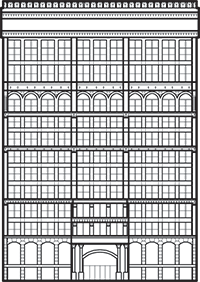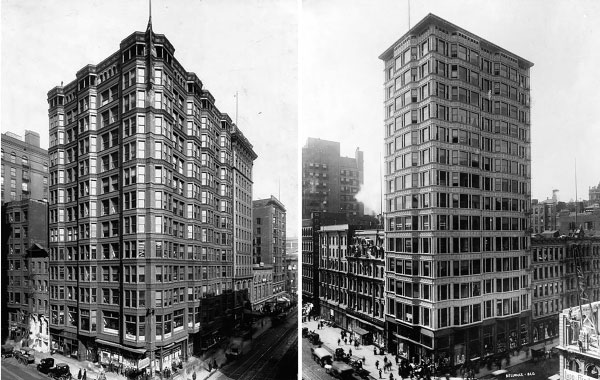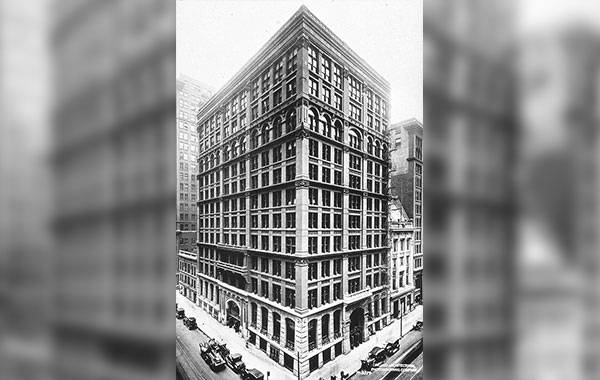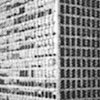Home Insurance Building
Chicago
This project is a renovation and replaced Home Insurance Building (Previous)
- CTBUH Drawing
- Facts
-
Metrics
You must be a CTBUH Member to view this resource.
- Structure
To Tip:
Height is measured from the level of the lowest, significant, open-air, pedestrian entrance to the highest point of the building, irrespective of material or function of the highest element (i.e., including antennae, flagpoles, signage and other functional-technical equipment).Architectural:
Height is measured from the level of the lowest, significant, open-air, pedestrian entrance to the architectural top of the building, including spires, but not including antennae, signage, flag poles or other functional-technical equipment. This measurement is the most widely utilized and is employed to define the Council on Tall Buildings and Urban Habitat (CTBUH) rankings of the "World's Tallest Buildings."Above Ground
The number of floors above ground should include the ground floor level and be the number of main floors above ground, including any significant mezzanine floors and major mechanical plant floors. Mechanical mezzanines should not be included if they have a significantly smaller floor area than the major floors below. Similarly, mechanical penthouses or plant rooms protruding above the general roof area should not be counted. Note: CTBUH floor counts may differ from published accounts, as it is common in some regions of the world for certain floor levels not to be included (e.g., the level 4, 14, 24, etc. in Hong Kong).
Official Name
Home Insurance Building
Type
Building
Status
Demolished
Completion
1890
Country
City
Address
Function
A mixed-use tall building contains two or more functions (or uses), where each of the functions occupy a significant proportion of the tower's total space. Support areas such as car parks and mechanical plant space do not constitute mixed-use functions. Functions are denoted on CTBUH "Tallest Building" lists in descending order, e.g., "hotel/office" indicates hotel function above office function.
Office
Structural Material
Both the main vertical/lateral structural elements and the floor spanning systems are constructed from steel. Note that a building of steel construction with a floor system of concrete planks or concrete slab on top of steel beams is still considered an “all-steel” structure as the concrete elements are not acting as the primary structure.
All-Concrete
Both the main vertical/lateral structural elements and the floor spanning systems are constructed from concrete which has been cast in place and utilizes steel reinforcement bars and/or steel reinforced concrete which has been precast as individual components and assembled together on-site.
All-Timber
Both the main vertical/lateral structural elements and the floor spanning systems are constructed from timber. An all-timber structure may include the use of localized non-timber connections between timber elements. Note that a building of timber construction with a floor system of concrete planks or concrete slab on top of timber beams is still considered an “all-timber” structure as the concrete elements are not acting as the primary structure.
Mixed-Structure
Utilizes distinct systems (e.g. all-steel, all-concrete, all-timber), one on top of the other. For example, a Steel Over Concrete indicates an all-steel structural system located on top of an all-concrete structural system, with the opposite true of Concrete Over Steel.
Composite
A combination of materials (e.g. steel, concrete, timber) are used together in the main structural elements. Examples include buildings which utilize: steel columns with a floor system of reinforced concrete beams; a steel frame system with a concrete core; concrete-encased steel columns; concrete-filled steel tubes; etc. Where known, the CTBUH database breaks out the materials used within a composite building’s primary structural elements.
Iron-Steel Composite Over Iron Over Iron-Masonry Composite
Height
55 m / 180 ft
Floors Above Ground
12
Structural Details:
Floors 1 – 2
Floors 3 – 6
Floors 7 – 12
Construction Schedule
Completed
Demolished
You must be a CTBUH Member to view this resource.
Architect
Usually involved in the front end design, with a "typical" condition being that of a leadership role through either Schematic Design or Design Development, and then a monitoring role through the CD and CA phases.
William LeBaron Jenney
CTBUH Initiatives
Height: The History of Measuring Tall Buildings
16 December 2009 - CTBUH News
Videos

16 March 2017 | Chicago
Building Tall Skyscraper Lecture Series: How High Can We Go?
Thursday, March 16, 2017. Chicago, United States of America. Hosted in collaboration with the Chicago Architecture Foundation, the first lecture of the series Building Tall...
Research

01 March 2020
“Buildings Without Walls:” A Tectonic Case for Two “First” Skyscrapers
Thomas Leslie, Iowa State University
“A practical architect might not unnaturally conceive the idea of erecting a vast edifice whose frame should be entirely of iron, and clothing the frame--preserving...
Research

01 March 2020
“Buildings Without Walls:” A Tectonic Case for Two “First” Skyscrapers
Thomas Leslie, Iowa State University
“A practical architect might not unnaturally conceive the idea of erecting a vast edifice whose frame should be entirely of iron, and clothing the frame--preserving...

01 March 2020
The Elevator, the Iron Skeleton Frame, and the Early Skyscrapers: Part 2
Gerald R. Larson, University of Cincinnati
In Part One, I documented the evolution of the use of the elevator and the iron frame to build ever-taller buildings that would eventually be...

11 October 2019
Was the Home Insurance Building The “First Skyscraper”?
Mir M. Ali, School of Architecture, University of Illinois at Urbana-Champaign; Gerald Larson, University of Cincinnati
Chicago’s Home Insurance Building, the 12-story office building designed by William Le Baron Jenney, completed in 1885 and demolished in 1931, has frequently been referred...

01 March 2018
Designing the High-Rise Building from the Inside/Out
Timothy Johnson & Jonathan Ward, NBBJ
For over 100 years, the tall building has largely advanced in technological innovation; however very little has been done in the terms of understanding the...

01 March 2018
Dynamic Interrelationship between the Evolution of the Structural Systems and Façade Design in Tall Buildings
Kyoung Sun Moon, Yale University School of Architecture
The emergence of tall buildings in the late 19th century was possible by using new materials and separating the role of structures and that of...

01 February 2011
The Origin of the Skyscraper
Gerard Peet, Rotterdam University of Applied Sciences, The Netherlands
The modern skyscraper is generally considered to be an American invention. Chicago and New York claim they once hosted the world's first skyscraper and many...

12 June 2008
The Tallest Buildings in the World: Past, Present & Future
CTBUH Research
Over time, the average height of the 100 tallest buildings in the world has been steadily increasing. However, by 2010, this average height will have...

26 February 2001
BUILDING SYSTEMS AND CONCEPTS - Structural Innovation
William F. Baker, SOM
Mankind had always lived close to the ground. During the thousands of years that preceded the birth of the skyscraper, life was limited by a...
Subscribe below to receive periodic updates from CTBUH on the latest Tall Building and Urban news and CTBUH initiatives, including our monthly newsletter. Fields with a red asterisk (*) next to them are required.
View our privacy policy




